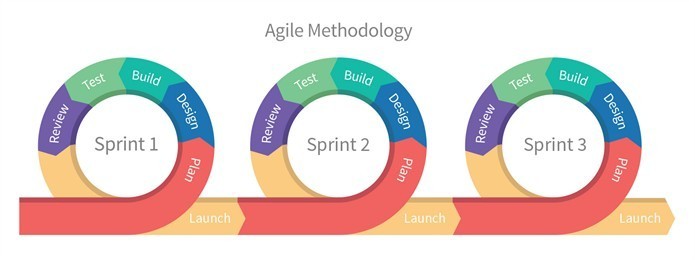Download the PDF version of this eBook.
Table of Contents
Introduction
In the last decade, the way that we develop software has shifted dramatically. The long term development of monolithic applications with annual release cycles has given way to rapid developments and deployments broken down into smaller, manageable sprints.
The business logic behind agile development is sound: development is driven by data and business needs, not by guesswork. The only way to see if the project is a success is to see it in action. And now, when a project fails, it can fail faster and better, moving on quickly to the fix.
So how do we use the agile methodology to avoid ultimate project failure? What if a project using the traditional waterfall methodology is already on its way to failure? Can we save it using agile? This ebook will help answer some of these questions, discuss the benefits of agile over waterfall development, and provide advice for what to do when met with the possibility of failure.
What is Waterfall Development?
Waterfall is a traditionally taught, old school method of software development. It involves a set process of analysis, design, implementation, testing, deployment over the entire project lifecycle. Waterfall is done in phases: each stage is completed at one time, then the team moves on to the next phase. All analysis is completed, then all design, etc.
This is the way things have been done for a very long time. It’s stuck because the waterfall process is easy to remember. It’s seen as the “easiest” or “most logical” way of doing things. Because waterfall puts one foot in front of the other, it follows a path which makes sense on the surface.
When you actually try to accomplish a project using the waterfall methodology, everything goes wrong. It’s susceptible to many issues, but two of the top issues are budgetary and overall risk.
Top Issues with the Waterfall Methodology:
Going Over Budget
Risk of Project Failure

How Agile Development Can Help Avoid Project Failure
Is this you?
What to Do First to Avoid Project Failure:
Assess how familiar you are with agile.
Identify your organization’s familiarity with agile development.
It’s easy to manage budgets on an agile project. You divide the work into manageable, ROI-driven sprints. By the nature of the agile methodology, you immediately know what you’re setup to accomplish. Those sprints produce ready-to-use deliverables that the customer can see, interact with, critique, and provide direction.
It’s almost like you’re moving the ball in-by-inch in agile, versus waiting in the end zone for someone to make a hail mary touchdown pass. The risk of project failure is mitigated because you have a complete understanding of how the project works after each deliverable sprint. This is called delivering the minimum viable product (MVP), or the minimum value the business needs to get value from the system.
Find the MVP
Become (or find) the Product Owner
Understand the Business Needs vs. Wants
How Agile Development Can Help Salvage a Failed Waterfall Project
Is this you?
What to Do First to Salvage a Failed Waterfall Project:
Perform a current state assessment.
Identify what’s been done wrong on the technical team side.
So your organization’s project is already failing. You have to try fix it. That’s not a fun place to be. But there’s still some hope. Take a deep breath and reset.
You have to re-think the entire project. Think through what has been done. Think about what the business actually needs. Correlate the needs with what has been done and what hasn’t. Analyze your product with the MVP in mind: work with the business unit to vote on what features are most important to the end result. Then prioritize your features and follow these steps:
Start Over
Develop Your Team
Get to "Done"
Work with an Agile Partner
Whether you’re looking for a way to salvage a waterfall project failure or prevent failure altogether, an expert vendor can help. Enterprise development projects take specialized skills and knowledge to ensure that they’re done correctly from start to finish. And most enterprises simply do not have access to this level of talent in-house.
Success
Support
Increased Collaboration or Integration
Expertise
Capabilities
Conclusion
Remember, the answer for how to avoid project failure or how to salvage a failing development project can seemingly be all over the place. But an agile methodology is a good start. Work together with the business unit, trusted vendor, and technical team to find out the business needs, determine the effort needed to complete the backlog, and how you’ll all reach the done state together.
About PITSS
PITSS modernizes, customizes, migrates, and extends the life of valuable legacy systems. Using data, proprietary software, and deep-dive analysis, we reduce the cost and scope of your digital transformation effort by focusing on the highest ROI processes first. Then, we pave the complete road between you and your new horizons with confidence and expertise. Our full-stack team of experienced UI/UX designers, developers, engineers, technical leads and project managers can guide you through each step of a project. No one knows Oracle Forms like we do—we can take you from planning, to pilot, to the cloud and beyond.
Meet our team to see how we can transform the systems that matter most to your business.

